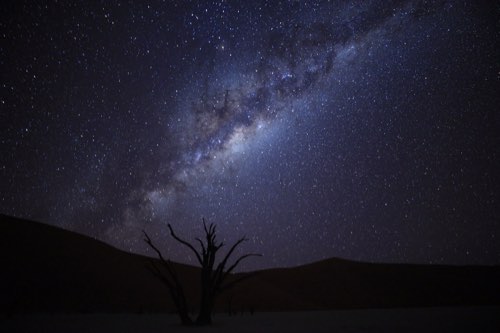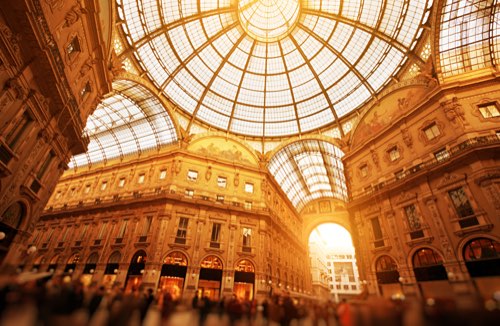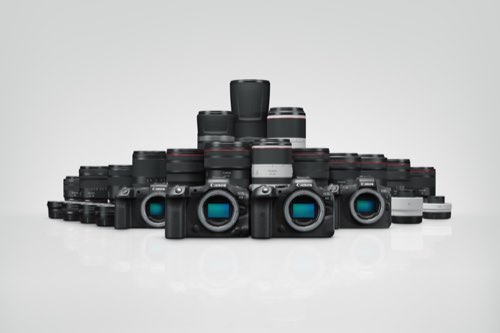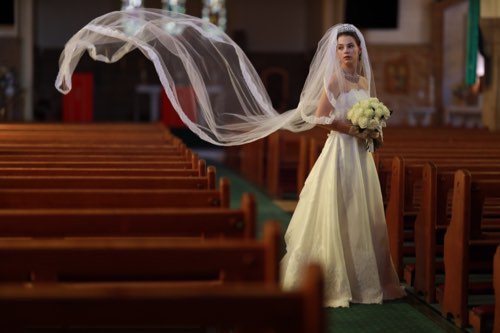Have you ever looked at a photographic masterpiece and wondered how the photographer managed to capture it? Here’s a not-so-secret secret: It’s in the lenses. How you choose and use them can make the difference between an ordinary shot and a compelling work. The first step is to know your options. Here’s an introduction to the different types of lenses and what they do.
Different lenses let you see the same scene in different ways
The features and specifications you find in your EOS R system camera can help you take amazing shots, but when it comes to creative expression, the key is in the lens.
Each type of lens has its own unique set of characteristics, which you can harness for different scenes and shooting intentions. From vast unfolding landscapes to fascinating close-ups of the tiny macro world, to the secret lives of wildlife and many more, changing your lens lets you discover things you might not have noticed otherwise.
Wide-angle lenses
EOS R5/ RF10-20mm f/4L IS USM/ FL: 10mm/ Bulb mode (f/6.3, 59.9 sec, EV ±0)/ ISO 100/ WB: Fluorescent
Shot with: Ultra-wide-angle lens
Key characteristics
- Capture more of a scene (larger field of view)
- Dramatic perspective exaggeration
- Larger depth of field = easier to keep more objects in focus
- Background blur is less obvious
Wide-angle lenses capture a field-of-view that is wider than what the human eye can see. For this reason, they are often used to photograph vast landscapes.
A lens is considered to be wide-angle if its effective focal length is 35mm or less. If its effective focal length is 24mm or shorter, it is considered an ultra-wide-angle lens.
Wide-angle lenses also exaggerate perspective, i.e., they can make nearby objects look bigger and nearer, and faraway objects look smaller and even further away. This characteristic is often used in architectural photography to make buildings look more impactful.
Because of the abovementioned strengths in capturing scenery and architecture, wide-angle (including ultra-wide-angle) lenses are great to have on hand when you travel.
More examples of what wide-angle lenses can do:
- Wide-Angle Lens Techniques: Composing Dynamic Portraits at 28mm
- Ultra Wide-angle Lens Technique: Light Trails from a New Perspective
- How to Create a Wide-Angle Panorama Portrait
Macro lenses
EOS R5/ RF100mm f/2.8L Macro IS USM/ FL: 100mm/ Aperture-priority AE (f/2.8, 1/2000 sec)/ ISO 400/ WB: Manual
Type of lens: Macro
Key characteristics
- Close-up details; fill the frame with small objects
- High maximum magnification
- Shallow depth of field during close-up shooting
Macro lenses are ideal for photographing plants, insects, food, trinkets and accessories, and other small subjects.
This is because they have:
- A very close focusing distance, which means that you can photograph your subject by putting your lens very close to it
- A high magnification ratio of at least 0.5x, which lets you achieve close-ups where the subject fills the frame. True macro lenses are capable of at least life-size (1x) magnification. The maximum magnification of the RF100mm f/2.8L Macro IS USM is 1.4x!
Macro lenses have a very shallow depth-of-field. This is great for creating bokeh (shallow focus effects) that makes subjects stand out. However, you will have to use a higher f-number than usual to get more in focus especially when shooting close-up, or try focus bracketing.
Also see:
Lens FAQ: What Images Can I Get with 0.25x or 0.5x Magnification?
More examples of what macro lenses can do:
- Capturing the Glory of Textures in Pictures
- How to Shoot Macro Portraits That Tell a Story
- The Art Behind the Shot: Morning Dew Bokeh Circles
Telephoto lenses
EOS R6/ RF100-400mm f/5.6-8 IS USM/ FL: 400mm/ Aperture-priority AE (f/8, 1/125 sec, EV -1)/ ISO 800/ WB: Auto<
Type of lens: Telephoto
Key characteristics
- Close-ups of faraway objects
- Perspective compression: “flattening”/stacking effect
- Shallower depth of field
Telephoto lenses “pull in” photographic subjects that are far away and make them look bigger and nearer than they really are. They are ideal for photographing wildlife, sports, car and bike races, and any other subject that is hard for you to shoot from up close.
Telephoto lenses are also known for their compression effect, which makes objects look closer to each other.
Compared to standard (normal) lenses, telephoto lenses can capture images with a larger background blur. This is due to two reasons:
i) A shallower depth-of-field
ii) Out-of-focus distant objects are also "pulled-in" and magnified, so the blurred areas look bigger.
You can use this characteristic to blur out distracting background elements and focus the viewer’s attention on your subject.
A fourth significant characteristic of telephoto lenses is that they result in less distortion compared to other types of lenses such as wide-angle lenses, which makes them ideal for portraiture.
There are three main subcategories of telephoto lenses:
- Medium telephoto lenses: focal length of 70mm to under 135mm
- Telephoto lenses: Focal length of 135mm or more
- Super telephoto lenses: Focal length of 300mm or more
More examples of what a telephoto lens can do:
- 5 Things to Try with a Telephoto Lens
- Composition Technique: Creating the Illusion of a Larger Moon
- Why Is a Super Telephoto Lens Necessary for Sports Photography?
Other ways of classifying lenses
“Wide-angle” and “telephoto” are categories that describe the field of view of a lens and suggest its effective focal length.
A macro lens is a special lens with the ability to focus extremely close with a high magnification ratio.
Here are three more major ways that lenses can be categorised.
1. Prime lens vs. zoom lens

A prime lens
Pictured:RF16mm f/2.8 STM

A zoom lens
Pictured:RF-S18-150mm f/3.5-6.3 IS STM
Zoom lenses can cover a range of focal lengths.
Prime lenses have a single fixed focal length.
Zoom lenses are more convenient for adjusting framing—you just need to turn the zoom ring. However, prime lenses mostly have larger (“brighter”) maximum apertures, which makes them better for creating shallow focus (“bokeh”) effects and shooting in low light.
When you get more familiar with photography, you will probably find that prime lenses help to expand your creative range.
Learn more about the differences between prime and zoom lenses and why they matter in:
Prime Lens or Zoom Lens: Which Should I Buy?
2. Lens mount (compatible camera)
Camera manufacturers make lenses for different camera bodies and image sensor sizes.
For example,
- RF lenses will not fit on EOS DSLRs or EOS M series mirrorless cameras because of the different lens mount.
- You will need the EF-EOS R mount adapter to use DSLR (EF or EF-S) lenses on EOS R series cameras.
- RF-S lenses are tailored for EOS R series cameras with APS-C size image sensors such as the EOS R50. They can also be used on a full-frame EOS R series camera in 1.6x crop mode, which records using part of the sensor.
Make sure you get the correct type of lens for your camera!

Using a mount adapter adds extra weight and length to your setup.
For more details, see:
What’s the Difference Between RF-S and RF Lenses?
RF Lenses vs EF Lenses: What's the Difference and How to Decide?
Know this: Crop factor
If you use a Canon APS-C camera like the EOS R50 or EOS R10, multiply the focal length in a lens name by 1.6x to get a true idea of the lens’ field of view on your camera. That’s because the focal length in a lens’ name is usually given in full-frame camera terms. The image on APS-C cameras is more “zoomed in” due to the APS-C crop factor, which is 1.6x on Canon APS-C cameras.
This crop factor could change the lens category. For example, on an APS-C camera, the popular RF50mm f/1.8 STM “nifty fifty” standard lens becomes like a mid-telephoto lens with a field of view similar to 80mm on a full-frame camera. This will be perfect for portraits, but a little too narrow for everyday shots.
Good to keep in mind especially if you want a wider lens!
(Learn more about this in Full-Frame vs APS-C Camera: Which Should I Choose?)
3. Professional-grade (L-series) lenses

A professional-grade lens
Pictured:RF14-35mm f/4L IS USM

A consumer lens
Pictured:RF15-30mm f/4.5-6.3 IS STM
If you notice a huge price (and size) difference between two RF lenses with the same focal length/similar focal ranges, the more expensive one is probably a professional grade lens. They have a red ring around the lens barrel and an “L” in the lens name.
Professional-grade lenses are designed with special glass to ensure the best possible optical quality. They also have a more robust build and weather-sealing for better durability under challenging weather conditions—which is also useful to hobbyists who frequently shoot outdoors.
Also see:
The RF f/4L Zoom Trinity: A Professional Lens “Starter Kit”
How do I decide which lens to get?
There are over 40 RF lenses available with more to come, in addition to over 90 EF lenses. Even after deciding whether you want a wide-angle, telephoto, or macro lens, there will still be several lenses in the same category. How do you choose the one that best suits your needs?
1. Consider the pros and cons of each type of lens
For example, professional grade zoom lenses with a large maximum aperture offer the most flexibility, but they are also heavier. Meanwhile, a prime lens’ fixed focal length might seem limiting at first, but its portability, low light performance, bokeh, and sharpness can be a source of encouragement and delight!


A camera with a standard zoom lens (left), and with a telephoto zoom lens (right). The camera body is the same for both, but the different lenses change the total weight and how the camera feels in your hands.
2. Consider your camera, your shooting style and the kind of images you want to shoot.
Most of the images here on SNAPSHOT have the name of the lens used to shoot them in the shooting information. If you come across an image you really like, study the lens used—even if the exact lens model is not suitable for your needs, it might help you narrow your options to similar models!

If you see an image you really like, look for the lens name in the shooting information.
Summing up
Ultimately, the best lens for you is the lens that helps you take the images that you envision. To find it requires knowing your needs, and knowing which lenses can meet them. The first part is a constant process of learning, exploration and self-discovery, and evolves as you grow as a photographer. The second part is about knowing your options.
Here on SNAPSHOT, you will find the information to help with both parts.
Our Lens Basics series will tell you more about the different types of lenses: Their merits and demerits, unique characteristics, and how you can use them. The Lenses FAQs series will go more into technicalities, tackling common (and not so common) questions about lenses and their specifications.
Meanwhile, in Key Features of RF Lenses, you will find lens reviews, comparisons, developers’ interviews and other information about specific models of lenses. Hopefully, these will help you in your quest to find the perfect match.



































.jpg)
.jpg)


